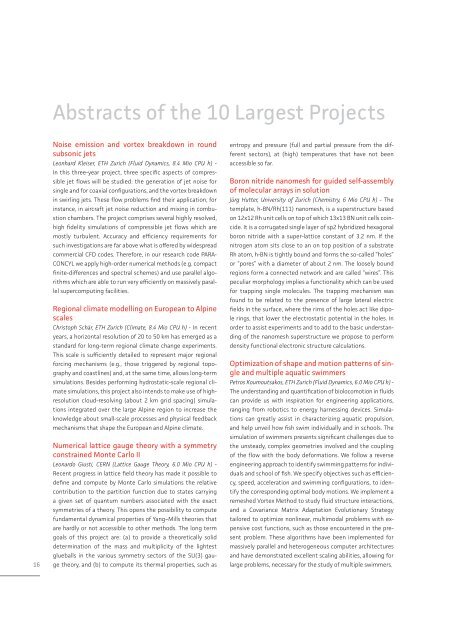Annual Report 2011 - CSCS
Annual Report 2011 - CSCS
Annual Report 2011 - CSCS
Create successful ePaper yourself
Turn your PDF publications into a flip-book with our unique Google optimized e-Paper software.
16<br />
Abstracts of the 10 Largest Projects<br />
Noise emission and vortex breakdown in round<br />
subsonic jets<br />
Leonhard Kleiser, ETH Zurich (Fluid Dynamics, 8.4 Mio CPU h) -<br />
In this three-year project, three specific aspects of compressible<br />
jet flows will be studied: the generation of jet noise for<br />
single and for coaxial configurations, and the vortex breakdown<br />
in swirling jets. These flow problems find their application, for<br />
instance, in aircraft jet noise reduction and mixing in combustion<br />
chambers. The project comprises several highly resolved,<br />
high fidelity simulations of compressible jet flows which are<br />
mostly turbulent. Accuracy and efficiency requirements for<br />
such investigations are far above what is offered by widespread<br />
commercial CFD codes. Therefore, in our research code PARA-<br />
CONCYL we apply high-order numerical methods (e.g. compact<br />
finite-differences and spectral schemes) and use parallel algorithms<br />
which are able to run very efficiently on massively parallel<br />
supercomputing facilities.<br />
Regional climate modelling on European to Alpine<br />
scales<br />
Christoph Schär, ETH Zurich (Climate, 8.4 Mio CPU h) - In recent<br />
years, a horizontal resolution of 20 to 50 km has emerged as a<br />
standard for long-term regional climate change experiments.<br />
This scale is sufficiently detailed to represent major regional<br />
forcing mechanisms (e.g., those triggered by regional topography<br />
and coastlines) and, at the same time, allows long-term<br />
simulations. Besides performing hydrostatic-scale regional climate<br />
simulations, this project also intends to make use of highresolution<br />
cloud-resolving (about 2 km grid spacing) simulations<br />
integrated over the large Alpine region to increase the<br />
knowledge about small-scale processes and physical feedback<br />
mechanisms that shape the European and Alpine climate.<br />
Numerical lattice gauge theory with a symmetry<br />
constrained Monte Carlo II<br />
Leonardo Giusti, CERN (Lattice Gauge Theory, 6.0 Mio CPU h) -<br />
Recent progress in lattice field theory has made it possible to<br />
define and compute by Monte Carlo simulations the relative<br />
contribution to the partition function due to states carrying<br />
a given set of quantum numbers associated with the exact<br />
symmetries of a theory. This opens the possibility to compute<br />
fundamental dynamical properties of Yang–Mills theories that<br />
are hardly or not accessible to other methods. The long term<br />
goals of this project are: (a) to provide a theoretically solid<br />
determination of the mass and multiplicity of the lightest<br />
glueballs in the various symmetry sectors of the SU(3) gauge<br />
theory, and (b) to compute its thermal properties, such as<br />
entropy and pressure (full and partial pressure from the different<br />
sectors), at (high) temperatures that have not been<br />
accessible so far.<br />
Boron nitride nanomesh for guided self-assembly<br />
of molecular arrays in solution<br />
Jürg Hutter, University of Zurich (Chemistry, 6 Mio CPU h) - The<br />
template, h-BN/Rh(111) nanomesh, is a superstructure based<br />
on 12x12 Rh unit cells on top of which 13x13 BN unit cells coincide.<br />
It is a corrugated single layer of sp2 hybridized hexagonal<br />
boron nitride with a super-lattice constant of 3.2 nm. If the<br />
nitrogen atom sits close to an on top position of a substrate<br />
Rh atom, h-BN is tightly bound and forms the so-called “holes”<br />
or “pores” with a diameter of about 2 nm. The loosely bound<br />
regions form a connected network and are called “wires”. This<br />
peculiar morphology implies a functionality which can be used<br />
for trapping single molecules. The trapping mechanism was<br />
found to be related to the presence of large lateral electric<br />
fields in the surface, where the rims of the holes act like dipole<br />
rings, that lower the electrostatic potential in the holes. In<br />
order to assist experiments and to add to the basic understanding<br />
of the nanomesh superstructure we propose to perform<br />
density functional electronic structure calculations.<br />
Optimization of shape and motion patterns of single<br />
and multiple aquatic swimmers<br />
Petros Koumoutsakos, ETH Zurich (Fluid Dynamics, 6.0 Mio CPU h) -<br />
The understanding and quantification of biolocomotion in fluids<br />
can provide us with inspiration for engineering applications,<br />
ranging from robotics to energy harnessing devices. Simulations<br />
can greatly assist in characterizing aquatic propulsion,<br />
and help unveil how fish swim individually and in schools. The<br />
simulation of swimmers presents significant challenges due to<br />
the unsteady, complex geometries involved and the coupling<br />
of the flow with the body deformations. We follow a reverse<br />
engineering approach to identify swimming patterns for individuals<br />
and school of fish. We specify objectives such as efficiency,<br />
speed, acceleration and swimming configurations, to identify<br />
the corresponding optimal body motions. We implement a<br />
remeshed Vortex Method to study fluid structure interactions,<br />
and a Covariance Matrix Adaptation Evolutionary Strategy<br />
tailored to optimize nonlinear, multimodal problems with expensive<br />
cost functions, such as those encountered in the present<br />
problem. These algorithms have been implemented for<br />
massively parallel and heterogeneous computer architectures<br />
and have demonstrated excellent scaling abilities, allowing for<br />
large problems, necessary for the study of multiple swimmers.


